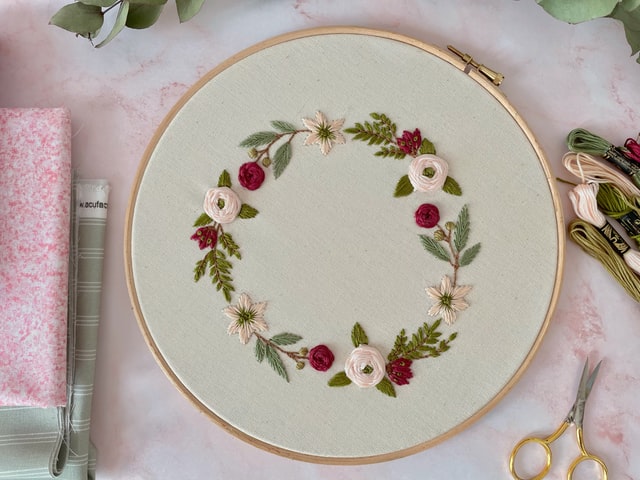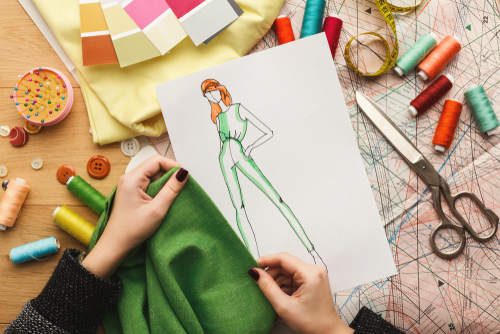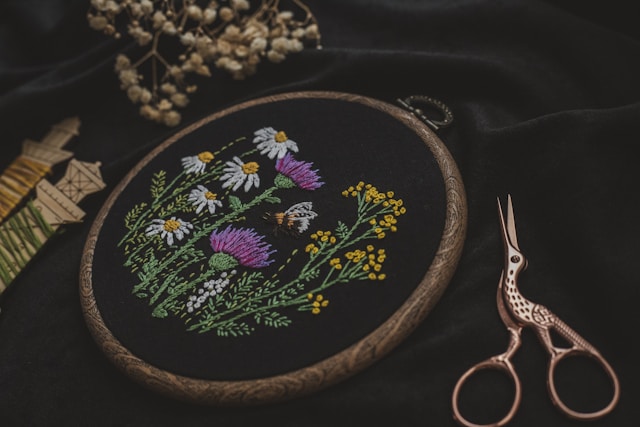Embroidery is an art which, sadly, does not have the same meanings that it used to enjoy in past times, when generations of brides-to-be, young women or genteel ladies spent hours hand-embroidering tea cloths, napkins, antimacassars, tablecloths, handkerchiefs, cushions, pillowcases and sheets, as well as other personal items which were much loved and valued by all those who received them. Somehow, I always tend to think of the characters in the Brontë sisters’ books quietly sitting with their embroidery throughout the turmoil of their lives …

Are there special skills needed in embroidery projects?
Embroidery requires a suitable material base, threads of various colours and thicknesses and needles, as well as a great deal of patience, accuracy and more than a little artistry. For someone like me though, embroidery is well out of my capability zone, as I cannot even hand sew a simple straight line! Embroidery, on the other hand, is a definite art form in which decorative designs are stitched into the fabric base.
Embroidery evolved naturally from a basic need to an art form
Although the art of embroidering textiles goes back as far as 30 000 BCE, it has had many uses during its history. Embroidery is an ancient craft, with a varied history and purpose. Its first practical use was in repairing worn-out clothing, since materials and clothing were expensive to produce pre the Industrial Revolution, so clothes and bedlinens were mended rather than being discarded. It was therefore a necessity for young women to learn basic needlework skills required in a family household and the 1700s saw the introduction of samplers. Wikipedia defines samplers as: “A needlework sampler is a piece of embroidery or cross-stitching produced as a ‘specimen of achievement’, demonstration or a test of skill in needlework. It often includes the alphabet, figures, motifs, decorative borders and sometimes the name of the person who embroidered it and the date.” The American colonies adopted the use of samplers to teach young girls numbers and the alphabet. Samplers were also used as a means of recording family history, Bible verses or reminders of wise sayings, such as: “Home Is Where the Heart Is”, or other sayings which reflected the values or traditions of the family or community. On a larger scale, we have tapestries depicting events such as battles or pastoral scenes, many of which involve a great deal of embroidery. As well as the Ancient Egyptians, Babylonians, Hebrews and Phoenicians used embroidery for decorating ceremonial garments or robes.
This art form goes back a very long way …
The origins of embroidery stem from China and the Near East. Embroidery itself is one technique of hand-stitching and decorating material, but there are others including crewel work, needlepoint, quilting, quillwork and featherwork. Evidence of these methods can be found in paintings in ancient Egyptian tombs, so hand-decorating materials for various purposes is certainly far from new, and evidence of embroidery can be found dating back to the 7th and 6th centuries BCE, where quilted garments were usually covered with embroidery.
Embroidery is a great option in branding and marketing promotions
Having said all of this, modern embroidery is still extremely popular, in the private, corporate and commercial sectors, and many companies employ marketing strategies which depend upon their brand or logo to be prominently displayed wherever possible, whether this is on billboards, packaging, advertisements, bunting, signage, mugs or wearables such as caps, T-shirts, socks, shoes, etc. Companies may host golf days – which are extremely popular – and give out branded advertising items such as golf balls, T-shirts, golf caps, towels, etc. Material items may be branded using either sublimation printing or embroidery, but embroidery adds that extra touch of class and durability to any garment. Embroidery can be produced in any design and colour – so basically to any specifications – which makes it extremely versatile. Nowadays, industrial and commercial embroidery machines and combination sewing-embroidery machines are used to embroider items faster, with a more uniform or identical appearance and are able to turn out large numbers of completed high-quality items within a relatively short period, which would not be possible with individual hand-stitching. These machines hold the area to be embroidered taut under the sewing needle via a hooping or framing system which moves the material automatically under the stationary needle position. Such embroidery machines work under the control of a computer which embroiders pre-stored patterns, and these machines may have multiple threads to speed the process up. Once the design has been downloaded and tested, the machine can continue to produce multiple items extremely efficiently and quickly.
If you want your linens to stand out, add embroidery!
There is no doubt that embroidery gives any garment a design edge which makes it durable and extremely appealing. Many people like to have their own “His” and “Hers” or initialised towels and pillowcases, with some going so far as to have the image of their pets embroidered onto clothing or cushion covers. Whatever you choose, there is an embroidery option to suit you, so go for something which will not degrade with time and wear, and add a few embroidered items to your home. For more tips, please see Uptasker’s articles on Embroidery Specialists.

